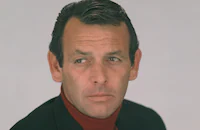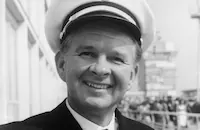Capitalizing on the science fiction craze that blazed through 1950s America, Universal International went back to their monster roots for a spell, and amongst classic titles like Creature from the Black Lagoon (1954), a female ‘monster’ flick stands out: Cult of the Cobra (1955). Boasting recognizable shades of many 1930s and 1940s horror entries, especially Cat People (1942), Cult of the Cobra leans more into the supernatural as opposed to sci-fi, following a group of American Air Force members on their last day in Asia who sneak into a snake-worshipping society meeting, blow their cover and are marked for death by a curse the Cobra Goddess, Lisa (Faith Domergue), must carry out. The beguiling Lisa follows the soldiers to New York and kills them one by one, falling in love with one of her intended victims, Tom (Marshall Thompson), along the way.
Jerry Davis, future producer of TV classics like Bewitched and The Odd Couple, was the first writer to board the project in early 1954, followed by Cecil Maiden and Richard Collins, the latter of whom went on to produce Bonanza. Though trade publications announced Ursula Thiess as Lisa in the summer of 1954, Universal was still sorting the cast out mere weeks and days before cameras rolled. By October 25th, one day before shooting began, Daily Variety confirmed that Domergue took over the lead. (Perhaps erroneously; Domergue remembered in later years that she replaced Mari Blanchard, who also tested for the role, after production started.)
Domergue undoubtedly wielded the most audience appeal of the cast, despite appearing in only a handful of films since becoming one of Howard Hughes’ lovers and starlets in the early 1940s. (Ironically, 1955 proved her most prolific year with five features released, including This Island Earth.) Domergue’s fame helped her command a salary higher than most, if not all, of her male co-stars and even director Francis D. Lyon, pulling in $4,000 more than the Oscar-winning editor of 1947’s Body and Soul, who transitioned to directing in 1952. Onscreen, Domergue received adequate support from the picture’s stable of G.I.s, which included a bevy of future TV stars: Richard Long (The Big Valley), Long’s real-life brother-in-law Marshall Thompson (Dakari), William Reynolds (The F.B.I.), Jack Kelly (Maverick) and David Janssen (The Fugitive). By the time Cult of the Cobra premiered on television in 1964, it became obvious how the picture was buoyed by its recognizable male TV luminaries and emerged as a small screen staple.
Cult of the Cobra officially started its 17-day shoot on October 26th, 1954, at Burbank’s Airway Bowling Lanes. The remainder of the movie was filmed on the Universal lot, where the Egyptian-set Abbott and Costello Meet the Mummy (1955) was also underway, which led to shared sets, props and extras. While Lyon recalled a smooth production, Kathleen Hughes, who appeared as Long’s fiancée, didn’t agree. She felt unsuited for her ingenue role and recalled being mistreated on set, in addition to being ill for several days. Consequently, many of her takes were flubbed or unused.
Cult of the Cobra shied away from special effects and excessive makeup for scares and instead employed a more suggestive Val Lewton-style approach, relying on Domergue’s subtle ominous vibe and Russell Metty’s moody cinematography to stimulate terror and stir the audience’s imagination. (Metty would lens 1958’s Touch of Evil and win an Oscar for 1960’s Spartacus.) To channel an air of trepidation, Metty captured the death scenes from two angles: one from the cobra’s viewpoint and the other with a prop snake in the frame, lending unique perspectives to the murders.
Originally set for a May release, Cult of the Cobra debuted March 29th, 1955 on a double bill supporting Revenge of the Creature (1955). The film also played second fiddle to titles like The Far Country (1954) and How to Marry a Millionaire (1953), as well as on its own in smaller venues. For a B-movie Universal didn’t have high hopes for, Cult of the Cobra’s reviews leaned positive, with many critics believing it capable of netting solid returns in the exploitation market and lauding the picture for its chilling atmosphere, suspenseful story and innovative shots. The Hollywood Reporter columnist Jack Moffitt commented that Lyon “has taken the sort of yarn that frequently is seen on Saturday afternoon in a small-town grind house and produced an intelligent horror-suspense story that should advance the careers of everyone in it.” While Cult of the Cobra didn’t catapult any of its cast or crew to superstardom, many subsequently found success on TV, which helped the picture endure and reach near cult-like status over the years.
Sources:
Lyon, Francis D. Twists of Fate: An Oscar Winner's International Career. Evanston Publishing, 1993.
Mitchell, Charles P., and Paul Parla. Screen Sirens Scream! McFarland, 2009.
Neibaur, James L. The Monster Movies of Universal Studios. Rowman & Littlefield, 2017.
Weaver, Tom, et al. Universal Terrors, 1951-1955. McFarland, 2017.
























